Biology Remove Summer Exam
1/93
There's no tags or description
Looks like no tags are added yet.
Name | Mastery | Learn | Test | Matching | Spaced |
|---|
No study sessions yet.
94 Terms
Enzyme Diagram
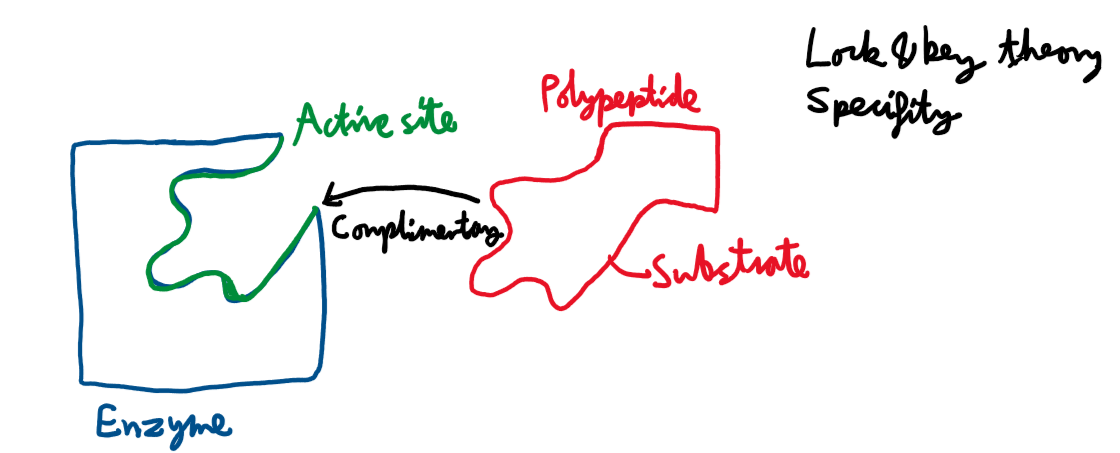
What is the role of enzymes?
Biological catalysts in metabolic reactions.
They increase the rate of reaction.
How does temperature affect enzymes?
At low temperatures enzymes will work slowly as there is not enough energy.
At very high temperatures, the enzymes will become denature as the active sites become deformed.
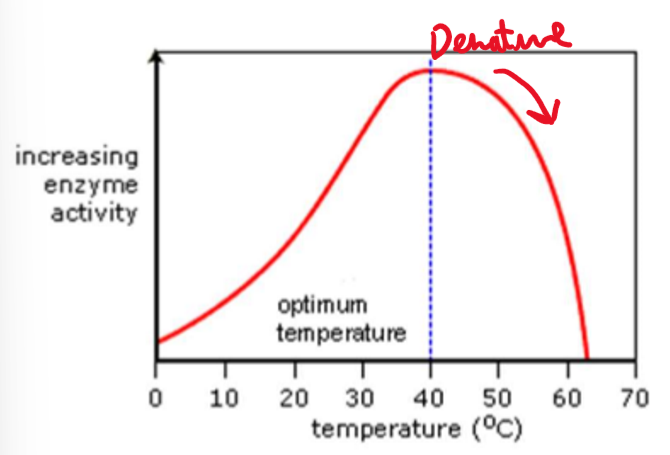
PRACTICAL: How enzyme activity can be affected by changes in temperature:
Change the temperature (20,30,40,50,60 degrees C)
Use the protease enzyme, trypsin and the protein milk powder, marvel.
Measure the time taken for marvel to turn colourless.
Do this by drawing an X on the bottom of the beaker and stop the time when you can see the X.
Measure the time in minutes and seconds using a stopwatch.
Keep the enzyme and substrate concentrations the same by measuring them.
Repeat five times and take an average.
How does pH affect enzymes?
At high and low pHs enzymes also become denatured as the active sites become deformed. Most enzymes work best at a pH of 7.
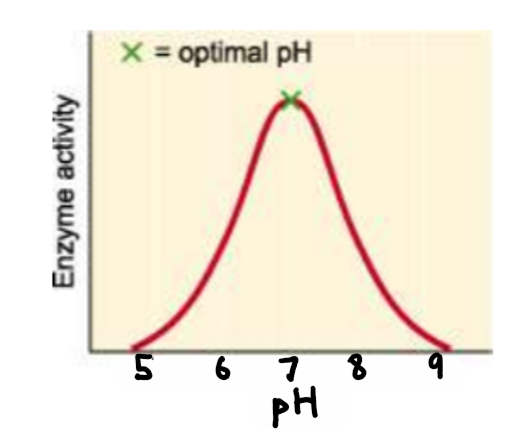
PRACTICAL: How enzyme activity can be affected by changes in pH
Change the pH level (3, 5, 7, 9).
Use the protease enzyme, trypsin and the protein milk powder, marvel.
Measure the time taken for marvel to turn colourless.
Do this by drawing an X on the bottom of the beaker and stop the time when you can see the X.
Measure the time in minutes and seconds using a stopwatch.
Keep the enzyme and substrate concentrations the same by measuring them.
Repeat five times and take an average.
Diffusion
The movement of particles from an area of high concentration to an area of lower concentration.
What factors affect the rate of diffusion?
Surface area to volume ratio, distance, temperature and concentration gradient.
What is the concentration gradient?
The difference in concentration of two areas.
The steeper the concentration gradient…
the faster the rate of diffusion.
PRACTICAL: Diffusion non-living system
Place a potassium permanganate crystal (purple) into water and observe the colour diffusing throughout the water.
PRACTICAL: Diffusion living system
Beetroot cells contain a purple pigment.
Place four cubes of beetroot in four test tubes filled with water and heat each test tube at a different temperature.
The higher the temperature, the faster the rate of diffusion.
What is respiration?
The release of energy (ATP) from glucose that takes place inside all living cells.
Aerobic respiration word equation:
Glucose + oxygen → carbon dioxide + water + energy (ATP)
Aerobic respiration symbol equation:
C6H12O6 + 6O2 → 6CO2 + 6H2O + 36ATP
Anaerobic respiration word equation:
glucose → lactic acid + energy
Differences between aerobic and anaerobic respiration:
Aerobic respiration uses oxygen and anaerobic does not.
Aerobic respiration produces more energy.
Aerobic respiration takes place in the mitochondria of a cell and anaerobic respiration takes place in the cytoplasm.
PRACTICAL: Investigate the evolution of carbon dioxide from respiring seeds
Place germinating seeds in one test tube and boiled seeds in another.
Suspend hydrogen carbonate indicator above the seeds using gauze.
Seal with a bung and leave for 1–2 days.
Observe the color change in the indicator.
PRACTICAL: Investigate the evolution of heat from respiring seeds
Place germinating seeds in one flask and boiled seeds in another.
Insert a thermometer into each flask.
Seal loosely with cotton wool.
Record temperature over several hours.
Repeat and take an average
Thorax structure
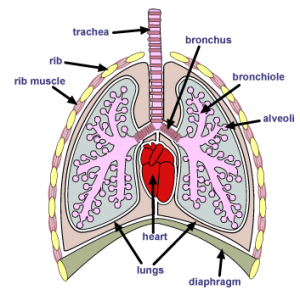
Role of diaphragm and intercostal muscles in ventilation
The diaphragm contracts and moves downwards.
The intercostal muscles contract and move the ribs upwards and outwards.
This increases the size of the chest and decreases the air pressure inside it which sucks air into the lungs.
How are alveoli adapted for gas exchange?
-Large surface area to volume ratio
-Lots of alveoli
-Walls of alveoli are thin (short diffusion distance)
-Good blood supply to maintain steep concentration gradient
What are the biological consequences of smoking in terms of cilia?
Cilia are small hairs in the trachea. They waft mucus up to the throat to be swallowed. The tar in cigarettes stops this process. Chest infections become more likely.
What are the biological consequences of smoking in terms of alveoli?
The walls inside the alveoli can become damaged, reducing the surface area for gas exchange. This could lead to emphysema.
What are the biological consequences of smoking in terms of the circulatory system?
The walls of arteries can be damaged by chemicals in the tar. This leads to a greater chance of blood clots forming and can lead to coronary heart disease.
Effect of exercise on breathing practical
Make on person run 1km and 1 person stand still.
After, measure the rise and fall of their chest (breaths) for 1 minute.
Repeat this and take an average.
PRACTICAL: Investigate the release of carbon dioxide in humans
Set up a boiling tube with hydrogen carbonate indicator.
Insert a delivery tube with a mouthpiece into the tube.
Exhale slowly through the mouthpiece into the solution.
Observe the change in the hydrogen carbonate indicator:
Compare results with a control tube containing the indicator not breathed into.
Repeat and take an average
Why do simple unicellular organisms rely on diffusion for movement of substances in and out of the cell?
They have a large surface area to volume ratio
Short diffusion distance
No need for a transport system
Why do multicellular organism need a transport system?
They have a small surface area to volume ratio
Large diffusion distance
More efficient
Blood is made up of:
Red blood cells, white blood cells, platelets and plasma
Role of plasma:
Transports carbon dioxide, digested food, urea, hormones and heat energy
Adaptations of red blood cells to transport oxygen:
-No nucleus makes more space for hemoglobin
-Biconcave disc shape causes a large surface area for fast diffusion
-Carries hemoglobin (binds to oxygen efficiently
How does the immune system react to disease?
By using white blood cells.
Roles of white blood cells:
-Produces antibodies to destroy microorganisms.
-Prevents disease by engulfing pathogens
Phagocytes
Engulf bacteria (pathogens)
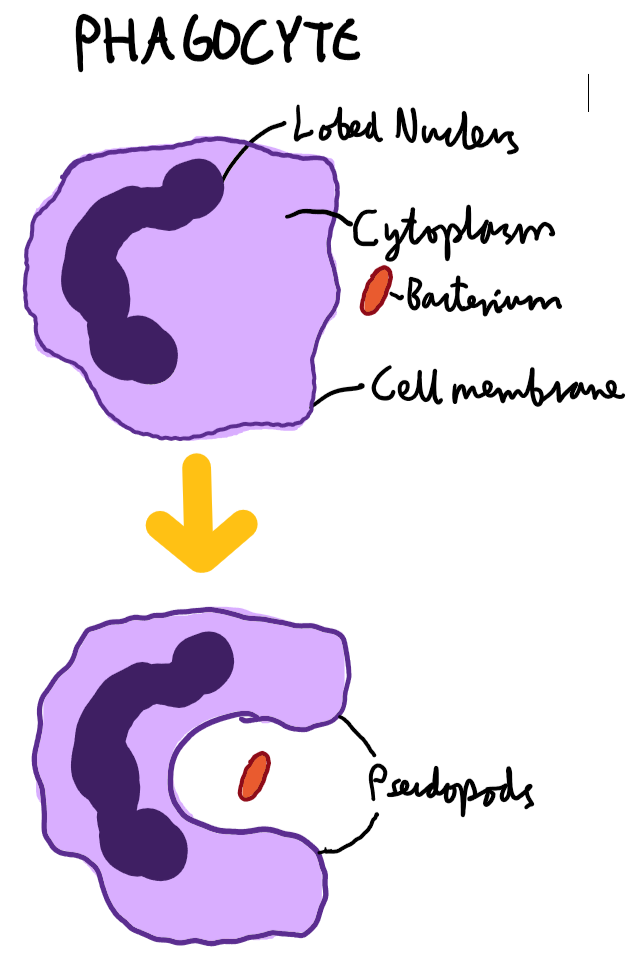
Lymphocytes
Produce antibodies to destroy pathogens.
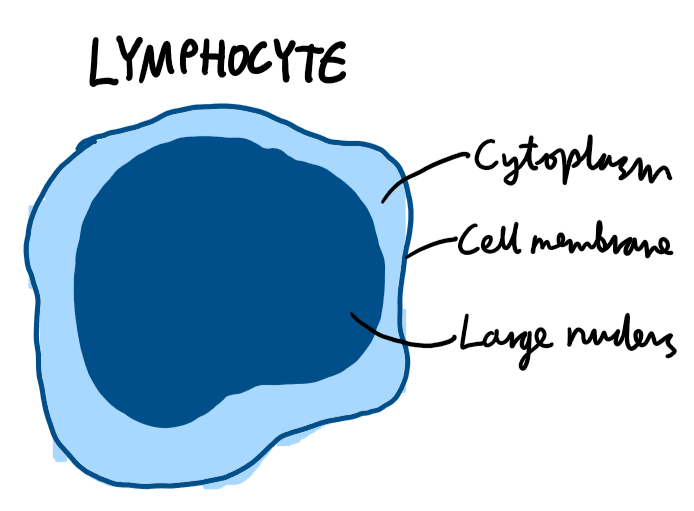
What does vaccination result in?
The manufacturing of memory cells (specialised blood cells that remember specific antigens) which enables future antibody protection to the pathogen to occur sooner, faster and in greater quantity.
How do platelets prevent blood loss?
They form clots which prevent blood loss and the entry of micro-organisms
Heart structure
Vein Cave
Pulled Arty
Aorta
Pulled Vein

How does the heart function?
The heart is a muscular pump. The right-hand side of the heart is responsible for pumping deoxygenated blood to the lungs. The left-hand side pumps oxygenated blood around the body.
How does heart rate change during exercise (adrenaline)?
-Muscles respire more (more energy)
-More oxygen used and more carbon dioxide produced
-Heart needs to deliver more oxygen to cells to meet demand
-High acidity in blood due to carbon dioxide
-Brain sends signal to pacemaker (increases heart rate)
Factors that increase the risk of coronary heart disease (disease leading to heart attacks):
Poor diet
Stress
Smoking
Lack of exercise
Artery and vein structure
Arteries carry blood under high pressure and veins carry blood under low pressure.
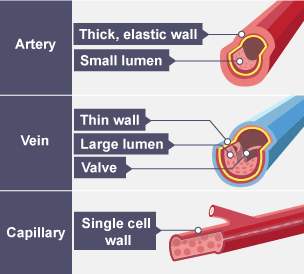
Capillary structure
One cell thick to allow for the exchange of materials.

Circulatory system structure
Brianna
Lunges
at Lively
Gutter
Kid
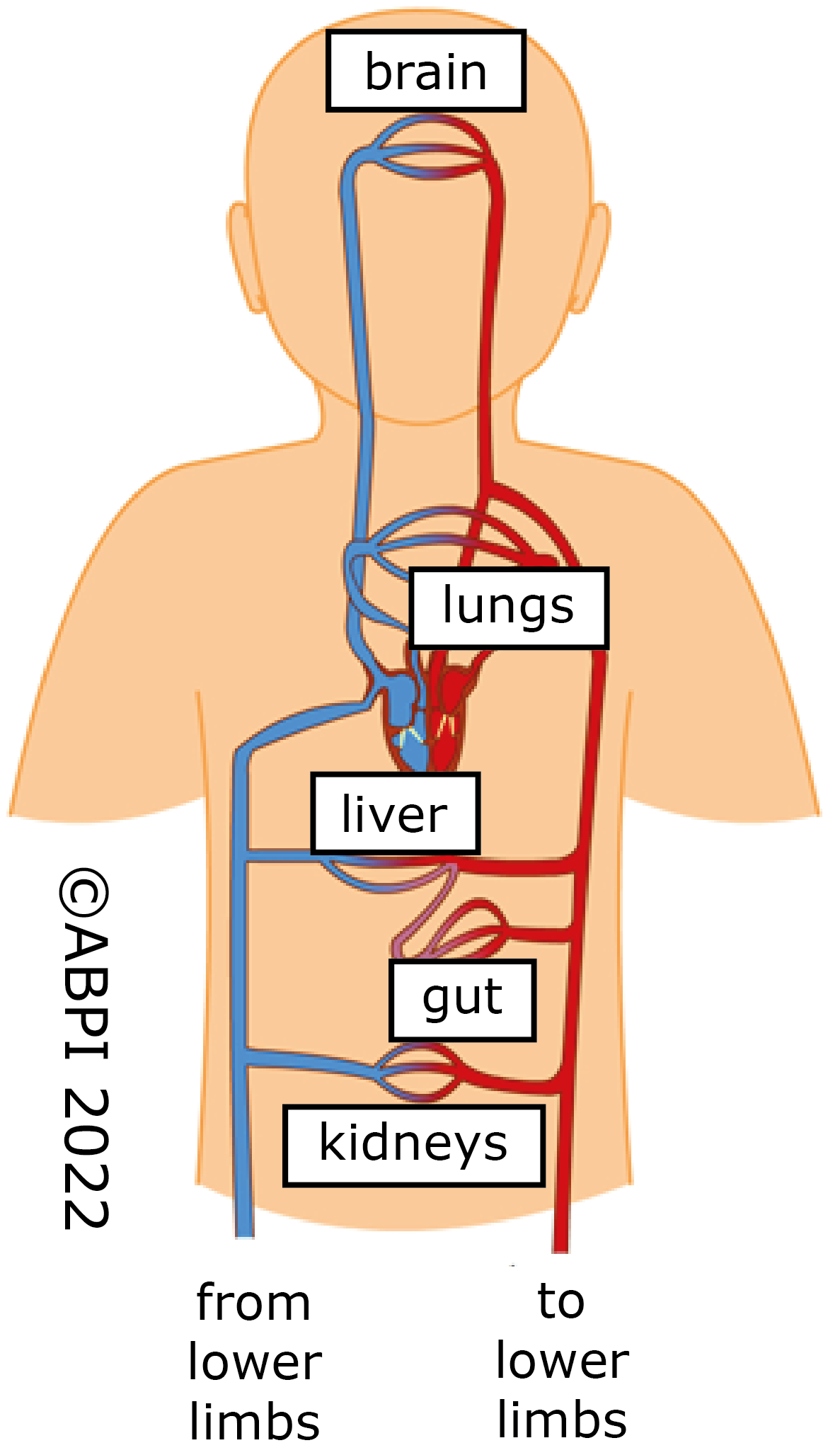
Sexual reproduction
Reproduction that involves the fusing of two gametes.
Asexual reproduction
Reproduction which does not involve the fusion of gametes.
Differences between sexual and asexual reproduction
Sexual reproduction takes more time and energy and has varying offspring. Asexual reproduction is quicker, uses less energy and has identical offspring.
Fertilization
The fusion of male and female gametes to form a zygote.
What does the zygote do?
It undergoes cell division and develops into an embryo.
Structure of an insect pollination plant
They are sticky, brightly coloured and scented.
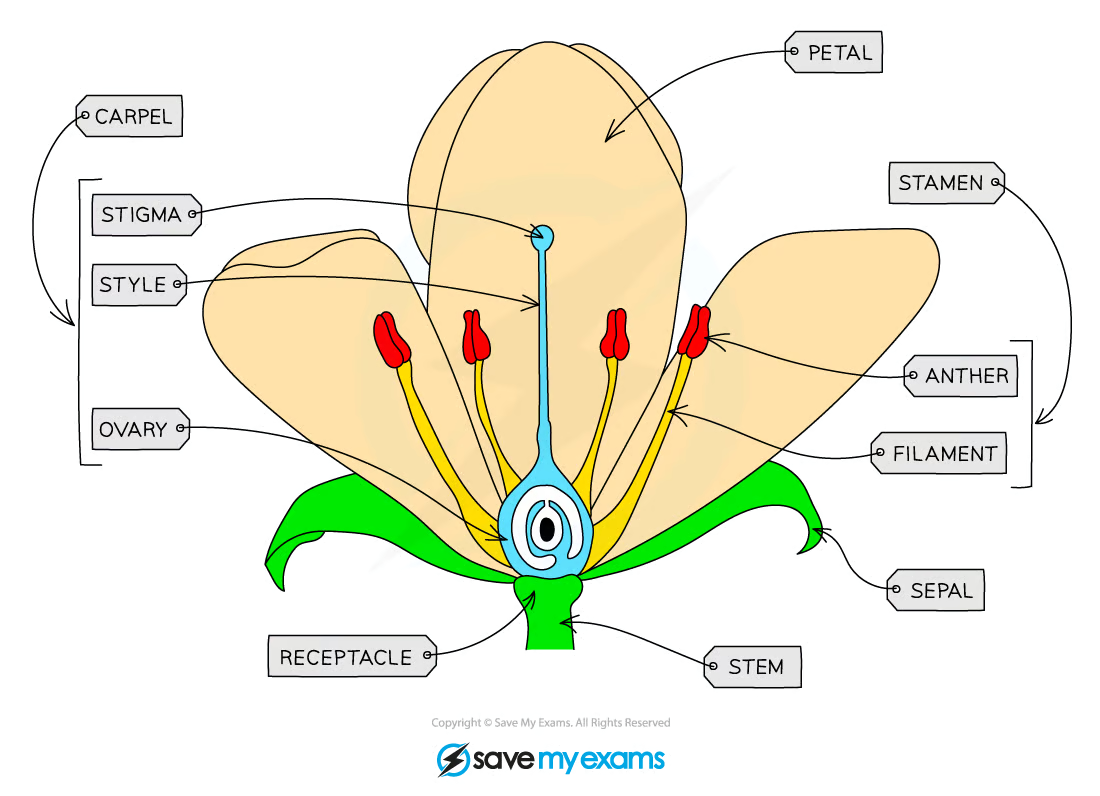
Structure of a wind pollination plant
Small, dull, scentless petals.
Long filaments and lots of pollen to be carried away by the wind.
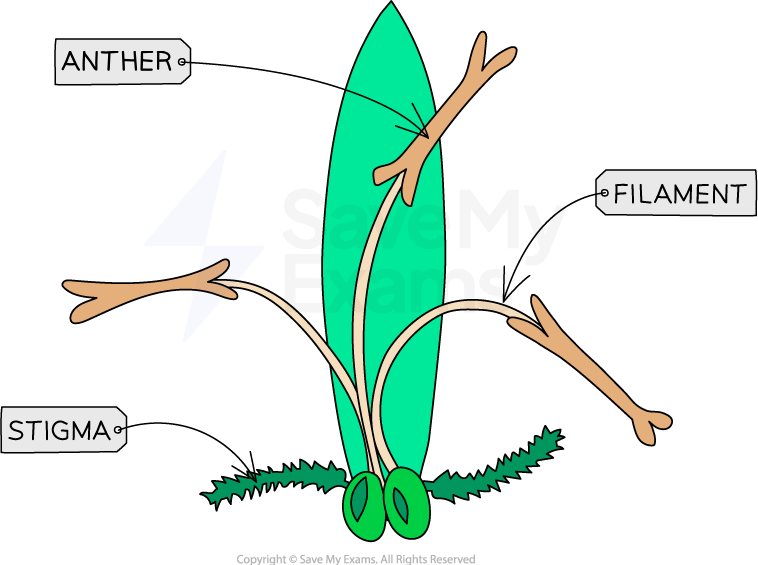
What leads to seed and fruit formation?
The growth of the pollen tube followed by fertilisation.
PRACTICAL: Investigate the conditions needed for seed germination
Place 10 cress seeds on top of some cotton wool in each of the 4 test tubes.
Tube A: Keep the cotton wool dry
Tube B: (CONTROL)Moisten the cotton wool with water
Tube C: Cover the seeds and cotton wool with water and add a layer of oil on top
Tube D: Moisten the cotton wool and place the tube in a fridge
Only seeds in test tube B will germinate.
What do germinating seeds utilize before they can carry out photosynthesis?
Food reserves
Plants can reproduce asexually by…
Natural methods (cuttings) and artificial methods (cuttings)
Human egg gamete structure and adaptations:
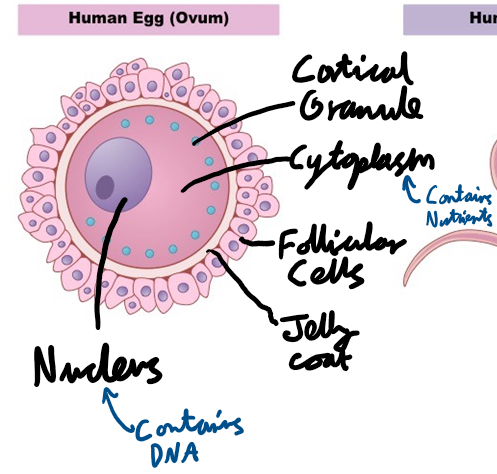
Human sperm gamete structure and adaptations:
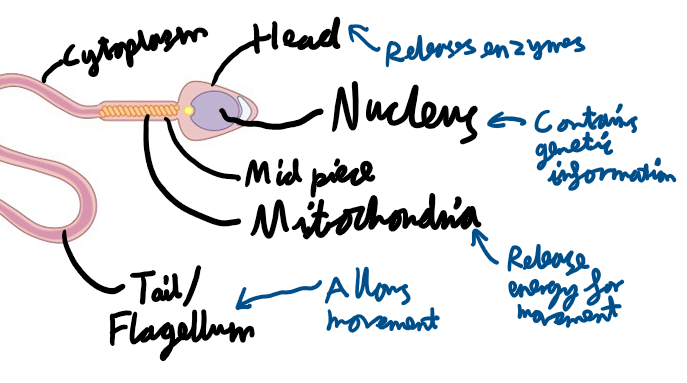
Oestrogen gland and role
Repairs uterus lining
Ovaries
Stops FSH being produces so that only one egg matures in a cycle).
Stimulates the pituitary gland to release LH
Progesterone gland and role
Maintains the lining of the uterus during the end of the menstrual cycle and pregnancy
Ovaries
Prevents other eggs from maturing
FSH gland and role
Pituitary gland
Causes an egg to mature in an ovary
Stimulates the ovaries to release oestrogen
LH gland and role
Pituitary gland
Triggers ovulation(the release of a mature egg)
The Menstrual Cycle: Days 1-5
The lining of the uterus is shed.
Days 5-14
FSH is released.
Oestrogen is released causing the uterus lining to thicken.
Production of LH begins.
Day 14
LH and FSH peak causing ovulation to occur. Estrogen levels decline.
Days 14-28
LH causes the development of corpus loetum. Progesterone is released.
Day 28
Levels of progesterone decline and the cycle starts again.
Role of the placenta in the nutrition of a developing embryo:
Protection of the fetus from mother’s immune system
Removes carbon dioxide
Exchange of soluble materials, e.g, glucose, vitamins, minerals - diffuse from the mother’s blood to the blood of the fetus
Secretion of hormones to maintain pregnancy
Helps with respiration
Placenta adaptations:
Large surface area for nutrient exchange.
Good blood supply leading to good diffusion.
Lots of villi further increasing surface area.
Amniotic fluid function
Surrounds the fetus and protects it from damage and temperature changes.
Effects of oestrogen
Development of breasts
Body hair grows
Menstrual cycle begins
Hips get wider
Effects of testosterone
Growth of penis and testes
Growth of facial and body hair
Muscles develop
Voice breaks
Testes start to produce sperm
What can be used to increase the yield of certain crops and how?
Greenhouses and polythene tunnels as temperature, light and CO2 can be controlled to maximise the rate of photosynthesis and increase yield.
How does increased carbon dioxide affect crop yield?
Increases the rate of photosynthesis.
Increases the sugars and amino acids produced.
Increase growth and therefore yield of plant.
How does increased temperature affect crop yield?
Increases rate of enzyme controlled reactions
Increases rate of photosynthesis
Increases the sugars and amino acids produced.
Increase growth and therefore yield of plant.
How does the use of fertiliser increase crop yield?
It increases the growth of the plant and therefore the crop yield.
Advantages and disadvantages of pest control (pesticides):
Advantages
Higher yield of crops
Larger profit and cheaper food
Pesticides decrease risk of catching diseases from rodents
Disadvantages
Can kill plants
Damage the ecosystem
Pesticides kill an estimated 30,000 people per year
Advantages and disadvantages of biological control
Advantages
Environmentally friendly
Cost-effective
Sustainable
No damage to plants
Disadvantages
Can have unpredictable, detrimental effects on non-target species
What is the role of yeast in food production?
It is used in wine making, beer making and bread making.
How is yeast used in bread making?
In bread making, yeast is used for fermentation, a process where yeast consumes glucose and produces carbon dioxide and alcohol.
PRACTICAL: Investigate the role of aerobic respiration by yeast in different conditions
Prepare 5 boiling tubes containing sugar solution and add yeast suspension.
Set up conditions to compare variables (e.g., different temperatures or pH levels).
Place cotton wool at the top of each tube to allow gas exchange.
Insert a delivery tube from each boiling tube into a second test tube containing limewater.
Place the boiling tubes in a water bath and leave them for a set period.
Observe and record:
The rate of bubble production.
Any cloudiness in limewater indicating CO₂ production.
How is lactobaccilius used in yoghurt production?
Lactobacillus bacteria are used in yoghurt production to ferment the lactose sugar in milk, converting it into lactic acid.
What is the role of an industrial fermenter?
It is used to grow microorganisms (e.g., bacteria or fungi) on a large scale to produce useful products like antibiotics, enzymes, or alcohol.
Why are aseptic precautions and nutrient supply important in a fermenter?
Aseptic conditions prevent contamination by unwanted microorganisms.
Nutrients (like glucose and minerals) provide energy and materials for microbial growth.
Why must temperature and pH be controlled in a fermenter?
Both affect enzyme activity.
Optimum levels ensure maximum growth.
Extremes can denature enzymes or slow microbial function.
Why are oxygen and agitation (mixing) necessary in a fermenter?
Oxygen is needed for aerobic respiration
Agitation ensures even mixing of oxygen, nutrients, and heat throughout the culture.
What are the methods used to farm large numbers of fish?
Protein
Removing waste products
Water quality
Controlling intraspecific and interspecific predation
Controlling disease
Controlling the quality and frequency of feeding
Selective breeding
What is the difference between interspecific and intraspecific predation
Interspecific is when one species feeds on another.
Intraspecific is when a species feeds on an organisms of the same species.
What does protein, water quality and controlling intraspecific and interspecific predation do for fish farming.
Protein - growth and repair
Water quality - Oxygen is needed for respiration to provide energy.
Predation - Nets for interspecific and separate by size and age for intraspecific.
What does controlling disease and removing waste products do for fish farming?
Disease - Likely to spread quickly due to proximity and kill fish. Can be prevented by antibiotics in water and removing dead fish.
Waste products - Can spread disease. Can be removed by filtering and regularly changing water.
What does controlling the quality and frequency of feeding and selective breeding do for fish farming?
Feeding - maximises their size and health
Selective breeding - get the largest and best fish. Breed best fish over many generations.
How can selective breeding develop animals/ plants with desired characteristics?
Select two organisms with a high yield/ desirable characteristics and breed them together.
Select offspring with highest yield/ desirable characteristics and breed them together.
Repeat over several generations until a very high yield is reached.
How can selective breeding develop plants with desired characteristics - PROCESS:
Cut off anthers
Transfer pollen using a paintbrush from the chosen plant
Place pollen on stigma
Keep flower isolated
Collect seeds
Grow desired plants
Repeat
C
O
R
M
M
S
S
Compare
Organism
Repeat
Measure
Measurement
Same
Same